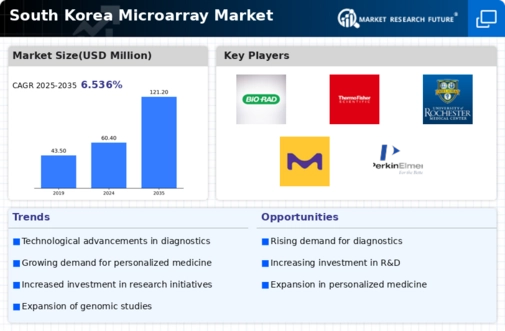The South Korea Microarray Market presents a dynamic competitive landscape characterized by rapid advancements in technology and increasing demand for high-throughput genomic analyses. As the country emphasizes research and development in the life sciences and biotechnology sectors, various players are striving to establish a significant foothold.
Microarray technology is widely utilized in applications such as gene expression profiling, genotyping, and disease diagnostics, making it a crucial area of focus for research institutions, hospitals, and pharmaceutical companies.
Market competitiveness is influenced not only by technological innovations but also by strategic collaborations, regulatory requirements, and the evolving landscape of personalized medicine.
A variety of local and international firms are vying for market share by offering innovative solutions tailored to the unique needs of researchers and clinicians in South Korea, which is contributing to a robust and competitive environment.
Agilent Technologies has a well-established presence in the South Korea Microarray Market, recognized for its high-quality products and cutting-edge technologies. The company offers a comprehensive suite of microarray solutions, which includes sophisticated platforms and reagents designed to support diverse applications in genomics research.
Agilent's strengths lie in its commitment to innovation and excellence in customer service, enabling researchers to conduct complex studies with greater efficiency and effectiveness. The company's local operations are supported by a team of experts facilitating both product support and training for users, thereby enhancing the overall customer experience.
Additionally, Agilent has been successful in forming strategic partnerships and collaborations with key research institutes in South Korea, allowing for the co-development of products that cater to the specific needs of the market, thus solidifying its competitive edge.
Illumina also maintains a prominent position in the South Korea Microarray Market, driven by its innovative technologies and robust product portfolio that includes sequencing and array solutions. The company is known for its next-generation sequencing (NGS) products, which complement its microarray offerings, providing researchers with an integrated approach for genomic analysis.
Illumina’s strengths in South Korea are augmented by its commitment to research collaboration, leading to advancements in personalized medicine and precision health initiatives. The company frequently engages in partnerships with local organizations and universities to support research projects and shares technological advancements that benefit the South Korean market.
Furthermore, Illumina has pursued mergers and acquisitions to bolster its capabilities and broaden its product range, establishing itself as a leader in the microarray domain. By focusing on innovative solutions that respond to the evolving demands of genetics and genomics research, Illumina continues to enhance its market presence in South Korea.
















Leave a Comment